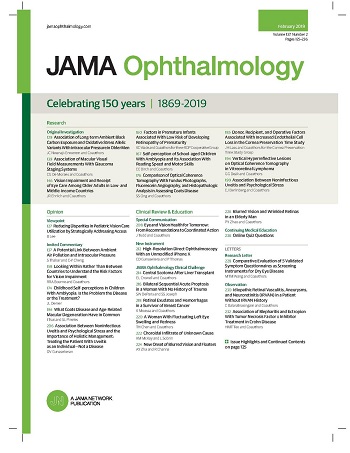Prostaglandin EP2 Receptor and Cystoid Macular Edema in Phakic Posttrabeculectomy Eyes.
IF 9.2
1区 医学
Q1 OPHTHALMOLOGY
引用次数: 0
Abstract
Importance Omidenepag isopropyl (OMDI), a prostaglandin EP2 receptor agonist, effectively reduces intraocular pressure but has a known risk of cystoid macular edema (CME), particularly in pseudophakic and aphakic eyes. Its safety profile in patients with phakic eyes, especially those with prior glaucoma surgery, warrants clarification. Objective To provide clinical characteristics and disease course of CME associated with OMDI use in patients with phakic eyes. Design, Setting, and Participants This is a retrospective medical record review of patients at a tertiary medical center seen between March 1, 2023, and March 31, 2024. The study included patients who were treated with OMDI following the introduction of OMDI eye drops at the institution. Data were analyzed on December 6, 2024. Exposures Topical OMDI ophthalmic solution, 0.002%, administered once daily. Main Outcomes and Measures Medical records were assessed on December 6, 2024, to characterize clinical findings before and after onset of OMDI-related CME, including ophthalmic examinations, optical coherence tomography (OCT) imaging findings, and treatment strategies, as well as time to anatomic recovery and visual acuity outcomes. Results A total of 836 patients with phakic eyes were treated with OMDI, of whom 86 had a history of trabeculectomy. CME developed in 8 eyes from 6 patients with prior trabeculectomy (age range, 41-61 years; median, 52.5 years), all occurring between 6 and 11 months after treatment initiation. During the study, the follow-up period after OMDI initiation was less than 6 months in 366 patients, 6 to less than 12 months in 419 cases, and 12 months or more in 51 patients. Baseline visual acuities with correction (range, 6/6 [20/20] to counting fingers), measured with the tumbling E chart, declined by 0 to 3 lines following CME onset. Three eyes received topical nonsteroidal anti-inflammatory drug treatment, 2 eyes required systemic corticosteroids, and 3 eyes recovered by discontinuing OMDI alone without additional therapy. Visual acuities, after CME resolved, ranged from 6/6 (20/20) to counting fingers at 28 to 91 days after discontinuing OMDI. Among the CME cases, postresolution follow-up ranged from 5.5 to 12 months, with no recurrence observed during this period. Conclusions and Relevance Cystoid macular edema can develop after initiating OMDI in patients with phakic eyes with a history of trabeculectomy prior to initiating OMDI. Further studies would be needed to understand the magnitude of this association and risk factors for this finding.前列腺素EP2受体与晶状体小梁术后黄斑水肿的关系。
omidenepag异丙基(OMDI)是一种前列腺素EP2受体激动剂,可有效降低眼压,但已知有囊样黄斑水肿(CME)的风险,特别是在假性晶状眼和无晶状眼中。对于有晶状眼的患者,尤其是有青光眼手术史的患者,其安全性值得进一步研究。目的探讨近视眼患者使用OMDI相关CME的临床特点及病程。设计、环境和参与者:这是对2023年3月1日至2024年3月31日在三级医疗中心就诊的患者的回顾性医疗记录回顾。该研究包括在该机构引入OMDI滴眼液后接受OMDI治疗的患者。数据于2024年12月6日进行分析。暴露:医用OMDI眼液,0.002%,每日1次。研究人员于2024年12月6日对医疗记录进行了评估,以表征omdi相关CME发病前后的临床表现,包括眼科检查、光学相干断层扫描(OCT)成像结果、治疗策略、解剖恢复时间和视力结果。结果836例晶状眼行OMDI治疗,其中86例有小梁切除术史。既往行小梁切除术的6例患者的8只眼发生CME(年龄范围,41-61岁;中位数为52.5年),均发生在治疗开始后6至11个月之间。在研究中,366例患者开始使用OMDI后随访时间小于6个月,419例患者随访时间小于6个月,51例患者随访时间大于或等于12个月。矫正后的基线视力(范围,6/6[20/20]到数手指),用翻滚E图测量,在CME发作后下降了0到3线。3只眼睛接受了局部非甾体类抗炎药治疗,2只眼睛需要全身皮质类固醇,3只眼睛在没有额外治疗的情况下停止单独使用OMDI后恢复。在停止使用OMDI后28至91天,CME消退后的视力从6/6(20/20)到数手指。在CME病例中,消退后随访时间为5.5至12个月,在此期间未观察到复发。结论及相关性:在实施OMDI前有小梁切除术史的晶状眼患者,在实施OMDI后可发生囊样黄斑水肿。需要进一步的研究来了解这种关联的程度和这一发现的风险因素。
本文章由计算机程序翻译,如有差异,请以英文原文为准。
求助全文
约1分钟内获得全文
求助全文
来源期刊

JAMA ophthalmology
OPHTHALMOLOGY-
CiteScore
13.20
自引率
3.70%
发文量
340
期刊介绍:
JAMA Ophthalmology, with a rich history of continuous publication since 1869, stands as a distinguished international, peer-reviewed journal dedicated to ophthalmology and visual science. In 2019, the journal proudly commemorated 150 years of uninterrupted service to the field. As a member of the esteemed JAMA Network, a consortium renowned for its peer-reviewed general medical and specialty publications, JAMA Ophthalmology upholds the highest standards of excellence in disseminating cutting-edge research and insights. Join us in celebrating our legacy and advancing the frontiers of ophthalmology and visual science.
 求助内容:
求助内容: 应助结果提醒方式:
应助结果提醒方式:


